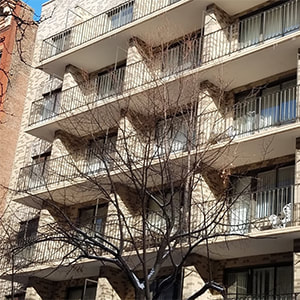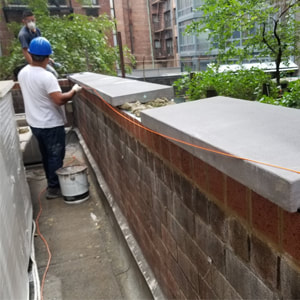FISP
|
What is FISP?
Also known as NYC Local Law 11/98, the Facade Inspection Safety Program (FISP) is a law that requires the inspection of a building's facades. Owners of buildings taller than six stories are required to have the building’s elevations inspected at least once every five years with emphasis given to the street-facing facades; and file a written report of the inspection findings with the New York City Department of Buildings (DOB). |
|
|
Facade inspections must be conducted, witnessed, or supervised by a "Qualified Exterior Wall Inspector" (QEWI). The NYC DOB can certify Registered Architects and Engineers as QEWIs once their qualifications are reviewed by members of the the NYC Facade Unit.
The QEWI will determine the facade/elevations that will be subject to a close up review. At least one of the facades must be inspected hands-on from a scaffold (or balconies and fires cores if available); the other surfaces are typically inspected using high-powered binoculars; through windows, and/or from balconies and fire escapes. he inspector documents the condition of the walls with notes and dated photographs; the written inspection report filed with the New York City Department of Buildings must include elevation and details photographs. The DOB launched a new system called DOB NOW SAFETY on September 12, 2016 that allows the QEWI to digitally submit the reports in a standardized format. |
After the Qualified Exterior Wall Inspector (QEWI) inspects the building façades, he assigns one of the following categories:
|
FISP PROJECTS
|
What are unsafe conditions?
Unsafe Conditions are typically items that could fall from a building):
|
Once a building has filed an Unsafe Report, the owner or manager must take the following steps:
|
|
What is considered SWARMP conditions?
SWARMP conditions are conditions deemed by the QEWI filing the FISP report to be Safe at the time of inspection, but at risk of developing into Unsafe conditions before the beginning of the next FISP cycle. Examples include:
If any SWARMP item is not repaired by the time the next cycle’s report is filed, the building may be automatically downgraded to Unsafe, regardless of the actual degree of physical danger posed by the cited condition. Outstanding SWARMP items cannot be carried over from one inspection cycle to the next. |
Deadline for conducting the facade inspections
In the first six inspection cycles, from 1980 to 2007, the DOB required all buildings to file their facade inspection reports in the same two-year window. To reduce the inspection, filing, and processing load, the DOB began staggering the filing deadlines starting with the last (7th cycle) in 2010. For the current Cycle (Cycle 9), buildings will have overlapping two-year windows for filing. Buildings are grouped according to the last digit of their block number:
|
Properties with more than one building
For properties with two or more buildings taller than six stories occupying different block numbers, the owner can file either of two ways:
New buildings
A newly constructed building is governed by FISP reporting requirements once five years have passed since the initial Temporary Certificate of Occupancy (TCO) was issued. An owner must comply with the first filing deadline for that property that occurs after the five-year TCO milestone has been reached (or the Final CO in the rare cases where a TCO was never issued).
Building with six stories plus cellar or basement
Many buildings, particularly in Queens and Brooklyn, have a Certificate of Occupancy that incorrectly lists the building’s height as six stories plus a cellar even though the building is actually six stories plus a basement or even six stories plus a full above-ground lobby level.
The distinction between cellar and basement is important. A cellar does not count as a story because more than half of its wall height is below ground level. A basement, does count as a story because more than half of its wall height is above ground. So a building with six stories plus a basement is considered 6½ stories high, which means a facade inspection report needs to be filed, regardless of what the Certificate of Occupancy says.
Height verification
A Height Verification Request Form can be completed by a QEWI, Owner and/ or Owner’s Representative and filed with the DOB to validate that a building is either above or below 6.5 stories in height.
FISP inspection report
Facade inspection reports must be filed no later than 60 days after the QEWI conducts the final inspection and no later than one year after the hands-on inspection. Building owners need to promptly approve, sign, and return reports to the QEWI for timely filing with the DOB to avoid the need for re-inspection.
Missed the inspection
A building cannot skip an inspection cycle, no matter how much time has passed since the deadline. If an inspection report has not been filed for a previous cycle, the DOB will issue a "No Report Filed" violation. Once the report has been filed, the DOB may then retroactively issue a base penalty of up to $1,000 for filing late, plus up to $250 per month past the deadline.
Sidewalk shed removal
A sidewalk shed installed along a facade with unsafe conditions must stay in place until either of two things happen:
Difference between an Amended Report and a Subsequent Report
DOB filing fees
The DOB charges a $265 fee for the initial filing of Local Law 11/98 reports and $100 for Amended or Subsequent Reports. There is also a fee of $135 for filing for a 90-day extension to repair unsafe items.
Penalty for not filing or filing a late report
Owners who fail to file a FISP report face a penalty of $250 per month past the deadline, with an additional penalty of $1,000 for each subsequent year past the deadline. In addition, owners who fail to correct any Unsafe condition face a $1,000 per month penalty until the condition has been corrected and an acceptable Amended Report has been filed.
Department of Buildings Links
Facades
Facade Safety Report
FISP Filing Instructions
Filing Fees & Penalties
For properties with two or more buildings taller than six stories occupying different block numbers, the owner can file either of two ways:
- The buildings can be filed separately based on the last digit of their block numbers.
- The group of buildings can be filed together under the filing window for any one of the buildings. The DOB must be notified of this intent at least 180 days before the end of the filing window.
New buildings
A newly constructed building is governed by FISP reporting requirements once five years have passed since the initial Temporary Certificate of Occupancy (TCO) was issued. An owner must comply with the first filing deadline for that property that occurs after the five-year TCO milestone has been reached (or the Final CO in the rare cases where a TCO was never issued).
Building with six stories plus cellar or basement
Many buildings, particularly in Queens and Brooklyn, have a Certificate of Occupancy that incorrectly lists the building’s height as six stories plus a cellar even though the building is actually six stories plus a basement or even six stories plus a full above-ground lobby level.
The distinction between cellar and basement is important. A cellar does not count as a story because more than half of its wall height is below ground level. A basement, does count as a story because more than half of its wall height is above ground. So a building with six stories plus a basement is considered 6½ stories high, which means a facade inspection report needs to be filed, regardless of what the Certificate of Occupancy says.
Height verification
A Height Verification Request Form can be completed by a QEWI, Owner and/ or Owner’s Representative and filed with the DOB to validate that a building is either above or below 6.5 stories in height.
FISP inspection report
Facade inspection reports must be filed no later than 60 days after the QEWI conducts the final inspection and no later than one year after the hands-on inspection. Building owners need to promptly approve, sign, and return reports to the QEWI for timely filing with the DOB to avoid the need for re-inspection.
Missed the inspection
A building cannot skip an inspection cycle, no matter how much time has passed since the deadline. If an inspection report has not been filed for a previous cycle, the DOB will issue a "No Report Filed" violation. Once the report has been filed, the DOB may then retroactively issue a base penalty of up to $1,000 for filing late, plus up to $250 per month past the deadline.
Sidewalk shed removal
A sidewalk shed installed along a facade with unsafe conditions must stay in place until either of two things happen:
- The DOB accepts the Amended FISP Report, upgrading the building status from “Unsafe” to either “Safe” or “Safe with a Repair and Maintenance Program.”
- A DOB inspector visits the property and agrees no unsafe conditions remain and authorizes complete or partial removal of the shed before filing and acceptance of the Amended Report.
Difference between an Amended Report and a Subsequent Report
- An Amended Report changes the status of a previously filed Unsafe Report to SWARMP or Safe.
- A Subsequent Report changes the status of a previously filed SWARMP report to Safe.
DOB filing fees
The DOB charges a $265 fee for the initial filing of Local Law 11/98 reports and $100 for Amended or Subsequent Reports. There is also a fee of $135 for filing for a 90-day extension to repair unsafe items.
Penalty for not filing or filing a late report
Owners who fail to file a FISP report face a penalty of $250 per month past the deadline, with an additional penalty of $1,000 for each subsequent year past the deadline. In addition, owners who fail to correct any Unsafe condition face a $1,000 per month penalty until the condition has been corrected and an acceptable Amended Report has been filed.
Department of Buildings Links
Facades
Facade Safety Report
FISP Filing Instructions
Filing Fees & Penalties




